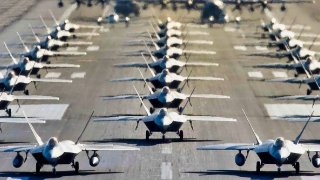U.S. Air Force Flew 26 F-22 Stealth Fighters At Once in Massive ‘Raptor Walk’
In 2020, an epic video depicting 26 F-22s partaking in an “Elephant Walk” on Joint Base Elmendorf-Richardson, Alaska, widely circulated.
The Air Force may have marked the F-22 for retirement once its secretive Next Generation Air Dominance sixth-generation fighter takes to the skies. Still, the legendary Raptor platform continues to wow aviation buffs.
F-22 Elephant Walk
In 2020, an epic video depicting 26 F-22s partaking in an “Elephant Walk” on Joint Base Elmendorf-Richardson, Alaska, widely circulated.
To show readiness when the COVID-19 pandemic emerged, these formidable fifth-generation airframes “walked” on the front line.
During the Second World War, large fleets of allied bombers would carry out attacks in missions sometimes containing up to 1,000 aircraft.
When these hefty platforms gathered in nose-to-tail formations, observers commented that it resembled the nose-to-tail formations of elephants when going to a watering hole.
Today, this term more often refers to larger training exercises, where a fleet of aircraft taxi, depart, or land to demonstrate readiness for combat.
However, elephant walks are also used to show off the size and skill of platforms - a “flex,” if you will.
A Truly Special Event
When dozens of F-22s gathered in an elephant walk in Alaska, the Air Force was reminding the rest of the world that the U.S. is in possession of one of the most advanced platforms to ever fly, which are all ready to take off and deploy if needed at a moment’s notice.
However, it is also important to note that positioning all of a fleet’s Raptors in close formation on a runway would be very unlikely if an actual war broke out since these airframes could be easily targeted.
What Makes the Raptor So Special?
The F-22 arguably changed the world of aviation when it was first introduced a quarter century ago.
As the first ever fifth-generation fighter jet to take to the skies, the Raptor placed America’s aerial capabilities way ahead of its adversaries.
In the 1980s, the Air Force recognized the need for an Advanced Tactical Fighter that could replace the aging F-15 Eagle and F-16 Fighting Falcon.
The former Soviet Union was ramping up its own aerial programs, and the U.S. needed a cutting-edge platform to counter it.
With a radar cross-section around five to seven times smaller than the newer and more sophisticated F-35 Lightening II, the F-22 is the most undetectable fighter to fly the skies.
The platform is also powered by twin thrust-vectoring F119 turbofan engines, which allow the fighter to outperform all near-peers in a dogfight.
Despite the Raptors’ unparalleled capabilities, significant delays in production and extraordinary costs led to the program being cut short.
The Navy’s F/A-18 Super Hornet program commenced around the time of the Raptor and wholly entered into total production and operational combat service by the War in Iraq, unlike the F-22s.
Additionally, the newer and more technically advanced F-35 is much cheaper to produce than its fifth-generation predecessor.
Now that both Moscow and Beijing possess their own fifth-generation counterparts to the U.S., maintain an aerial edge over our top adversaries has never been more critical.
The Raptor program is set to retire once the Air Force’s NGAD fighter comes online.
However, this powerhouse platform will always have a legendary connotation. Some would even say that despite its age, the F-22 Raptor is the best fighter on planet Earth. No wonder the Air Force keeps tweaking its thoughts on a possible retirement on some of the older Raptor airframes in the service.
About the Author
Maya Carlin is an analyst with the Center for Security Policy and a former Anna Sobol Levy Fellow at IDC Herzliya in Israel. She has by-lines in many publications, including The National Interest, Jerusalem Post, and Times of Israel. You can follow her on Twitter: @MayaCarlin.


